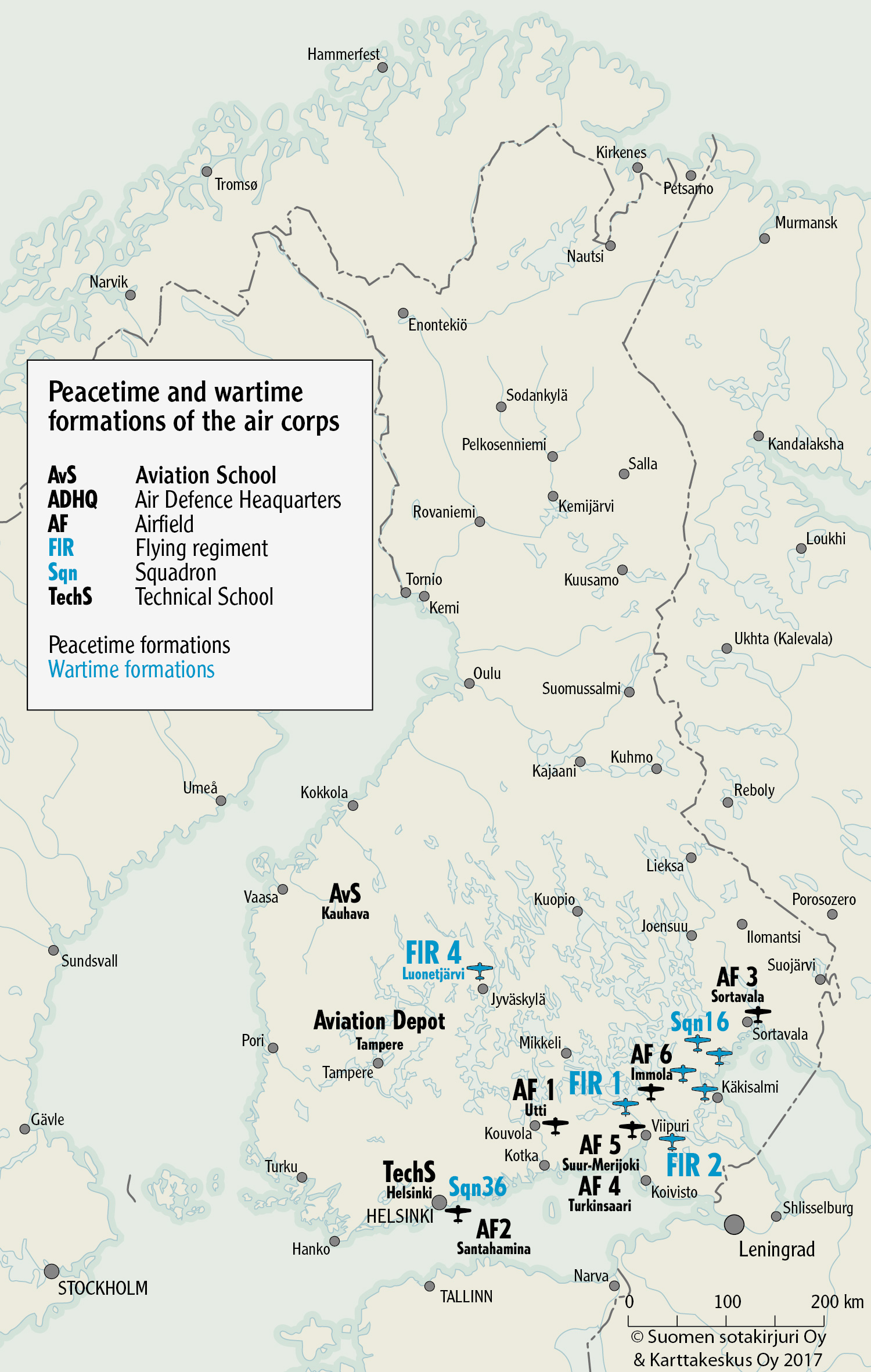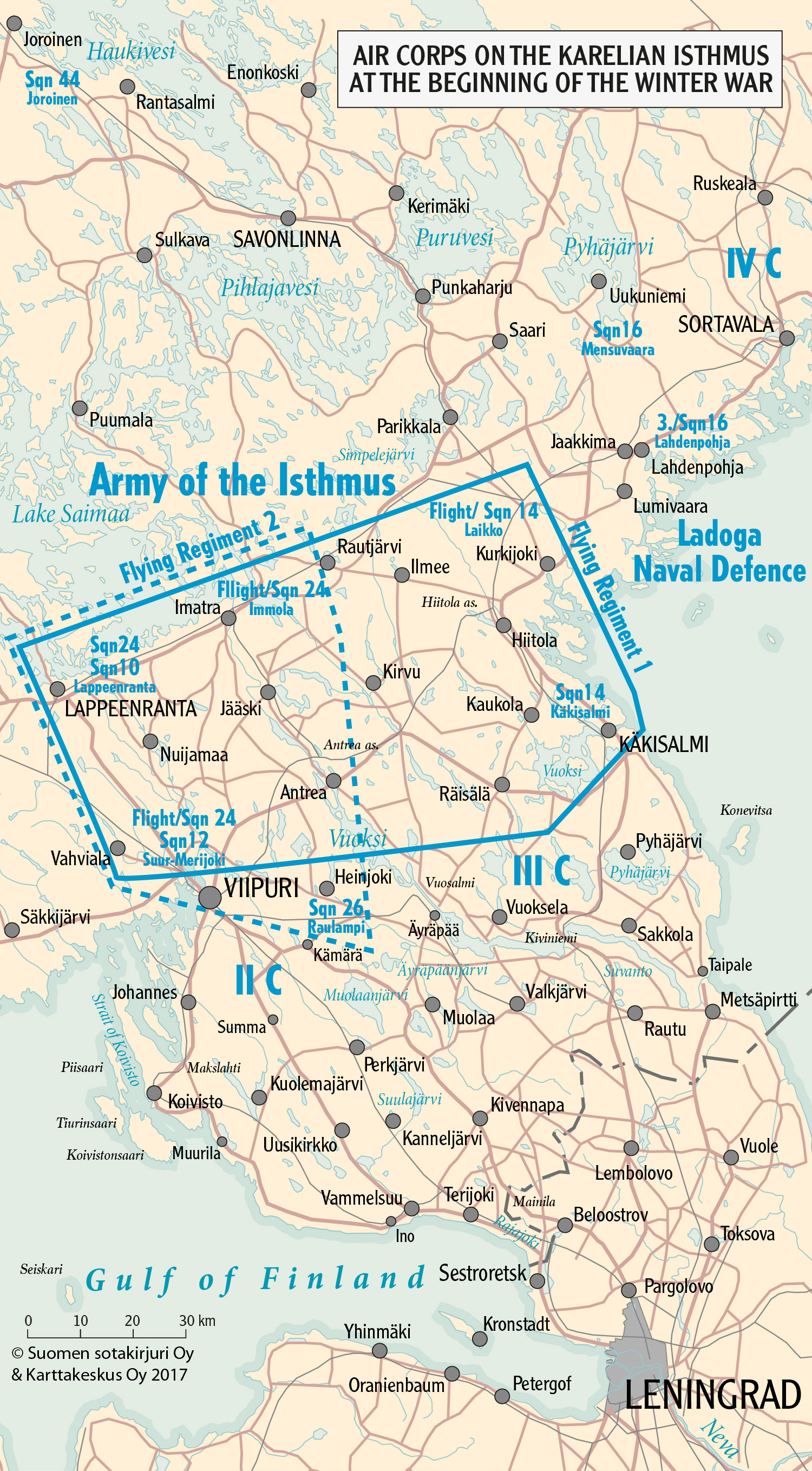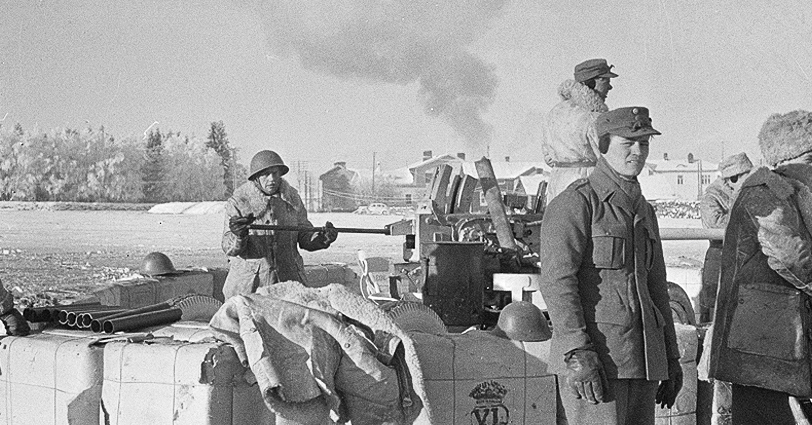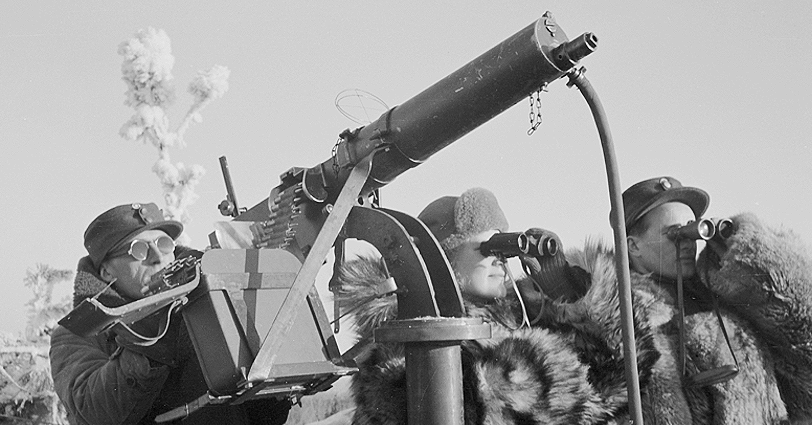Aerial warfare and air defence
The Finnish Air Force engaged in aerial warfare against a superior enemy. The operations were primarily counter-air missions against enemy bombers. The air force recorded approximately 200 instances of downed enemy aircraft. The air force primarily supported the Finnish Army with reconnaissance missions. The mission of the air defence forces was to protect the Finnish territory and the theatres of operations from aerial attacks, but the troops were undermanned for the task. The air defence forces recorded 300 instances of downed enemy aircraft. The Finnish Navy’s air defence and the Finnish Army’s other forces reported approximately 90 instances of downed enemy aircraft.
Air defence was led by the commander of the air force

Edited map from the work Raunio, Ari, Sotatoimet – Suomen sotien 1939−45 kulku kartoin (Military Operations – The Course of Finnish Wars in 1939–45 with Maps), 3rd edition, Karttakeskus 2013.
Finnish air defence was the responsibility of the air force, the air defence forces and the air surveillance forces. Jaeger Officer, Major General Jarl Lundqvist served as the commander of air defence. His command headquarters was the Air Defence Headquarters. It was located in Helsinki and was part of the General Headquarters.
Lundqvist’s subordinates at the Air Defence Headquarters included the commander of the air defence troops, Colonel F. Helminen. The Air Defence Office was also in charge of air surveillance. The office was headed by Captain P. Jokipaltio.
Civil defence was led by the head of civil defence
The Ministry of the Interior was in charge of civil defence. The operations were led by Jaeger Officer, Lieutenant General Aarne Sihvo, assisted by the Headquarters of the Head of Civil Defence. In January 1940, responsibility for civil defence in the theatres of operations was transferred under the military command, i.e. the Air Defence Headquarters. The Air Raid Protection Office was established there.
Peacetime formation of the air corps
The peacetime air defence comprised the Air Defence Headquarters (ADHQ), six airfields (AF 1, AF 2, AF 3, AF 4, AF 5 and AF 6), the Aviation School (AvS), the Technical School (TechS) and the Aviation Depot. The air corps had a little under 120 military aircraft at its disposal.
The aircraft operated in flying regiments

Edited map from the work Raunio, Ari, Sotatoimet – Suomen sotien 1939−45 kulku kartoin (Military Operations – The Course of Finnish Wars in 1939–45 with Maps), 3rd edition, Karttakeskus 2013.
The wartime air corps operated in three flying regiments (FlR 1, FlR 2 and FlR 4). Within the regiments, the aircraft were divided into squadrons (Sqn). Squadrons were further divided into flights. A liaison regiment (FlR 1) was subordinated under the name of Flight Group to the Army of the Isthmus. One of its squadrons (Sqn 16) was subordinated to the IV Corps, which operated in Ladoga Karelia and Border Karelia. One flight of this squadron (3rd/Sqn 16) was intended to support the Ladoga Naval Defence. The flight was relocated to the North Finland Group’s area in December. One squadron (Sqn 36) that did not belong to the flying regiments was subordinated to the commander of the navy, primarily for naval reconnaissance.
The Finnish Air Force was outnumbered
During the Winter War, the Soviet Union’s aircraft outnumbered Finland’s aircraft several times over, with the difference in power increasing to up to 20 to 1 over the course of the war. According to some data, the number of Soviet military aircraft at the Finnish front increased from approximately 800 to up to 3,200 during the Winter War. Only 70 of the Finnish Air Force’s approximately 120 military aircraft were modern.
Despite the Soviet Union’s great air superiority, the Finnish Air Force was able to operate throughout the war. The Finnish fighters’ main targets were enemy bombers at the rear of the theatres of operations and on the home front. Finland’s modern Bristol Blenheim bombers were also used for the supreme command’s strategic reconnaissance. Bombers were unsuitable for providing direct support to Army forces.
The Finnish Air Force’s resources were insufficient for efficient counter-air defence in the theatre of operations and for supporting the Army forces with aerial attacks. The air force mainly supported the Army forces with reconnaissance missions.
The air force was not prepared to use aircraft in Northern Finland
At the start of the war, Northern Finland was practically without air defence. The air force’s operations were focused on the Karelian Isthmus, where the Soviet Union also focused its air operations. However, the Soviet Air Force was also active in the northernmost parts of Finland from the start of the war. During the war, the Finnish Air Force’s operations further north primarily comprised occasional reconnaissance flights up to Suomussalmi’s latitude.
The F-19 Flying Regiment, formed by Swedish volunteers, started operating in Lapland in late January, with the Salla area as its focus. The regiment was equipped with aircraft of the Swedish Air Force, including 12 Gladiator fighters and 4 light Hart bombers. The aircraft were outdated.
Ground-based air defence forces protected the home front and the field army
Ground-based air defence was still a new military branch at the outbreak of the Winter War. The military branch was responsible for the ground-based air defence of both the home front and the field army. On the home front, important protected areas included the largest Finnish cities as well as railway junction stations. At the start of the additional refresher training in October, the ground-based air defence troops were too few in number to achieve both these main tasks. This was due to the small number of anti-aircraft guns and heavy machine guns. The frontline troops of the field army did not have the protection of ground-based air defence troops. The same applied to the home front in Northern Finland and Lapland.
Ground-based air defence protected 14 localities on the home front
At the start of the war, the commander of the Home Troops’ ground-based air defence forces commanded 14 heavy and 7 light anti-aircraft batteries and 2 anti-aircraft machine gun companies. The commander also commanded approximately 40 platoons, the majority of whose troops were armed with anti-aircraft machine guns. Their range was not long enough to fight bombers. Ground-based air defence troops were deployed in 14 localities. The largest numbers of troops were deployed to protect Helsinki, Viipuri (Vyborg) and Turku.
Swedish volunteers took charge of ground-based air defence in Lapland

Swedish air defence troops cleaning their anti-aircraft gun in Rovaniemi on 22 February 1940. SA-kuva.
A few units of the newly established air defence forces could be sent to defend the home front in Northern Finland during the war. The North Finland Group was assigned one anti-aircraft machine gun company after mid-December. At the end of December, a Swedish volunteer anti-aircraft company and battery arrived in Lapland from Sweden.
During the war, the air defence was extended to the divisions’ rear
The Finns were able to procure a considerable number of additional anti-aircraft weapons during the additional refresher training and the war. Finnish forces could send a part of the newly established ground-based air defence forces to the field army, even at the division level. These anti-aircraft detachments were so small that they were only able to protect small areas, primarily at a division’s rear.
Air raid protection of the home front
 I
I
An anti-aircraft machine gun on top of the tower of Imatran Valtionhotelli (lit. Imatra State Hotel) on 1 January 1940. The tower also held an air surveillance station. In the middle of the picture, a member of the Lotta Svärd organisation on air surveillance duty. SA-kuva.
The development of aerial warfare after the First World War highlighted the importance of protecting the home front from air raids. The success of this protection required a good air situation picture, protecting targets with anti-aircraft weapons and civil defence.
An air situation picture was assembled by area at regional air defence centres, which then distributed it to civil defence units, air defence troops and air corps.
At the start of the Winter War, the air defence forces focused on protecting the home front and the settlements located at the rear of the theatres of operations. Other important protected sites included bridges and rail routes.
Ari Raunio

 SUOMEKSI
SUOMEKSI PÅ SVENSKA
PÅ SVENSKA по-русски
по-русски